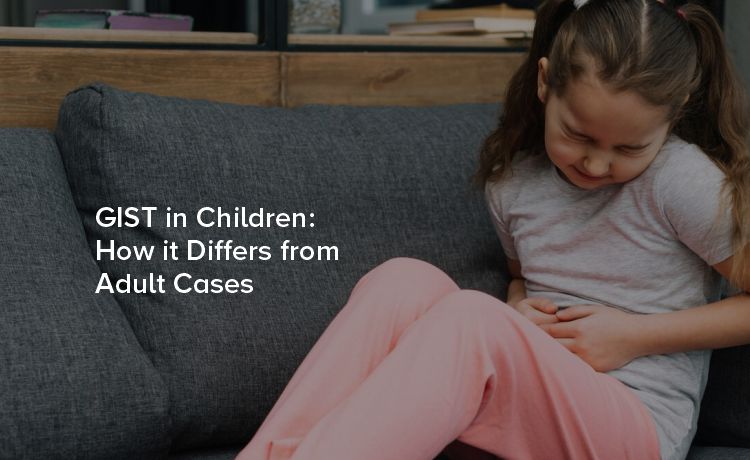
Gastrointestinal stromal tumors (GIST) are rare and complex, affecting both children and adults. However, the nuances that differentiate pediatric cases from adult ones make it crucial for parents, caregivers, and medical professionals to understand these distinctions.
Gastrointestinal stromal tumor (GIST) is a type of tumor that originates in the digestive tract. Most commonly found in the stomach and small intestine, GISTs arise from specialized cells known as interstitial cells of Cajal. These cells play a pivotal role in the autonomic nervous system, regulating digestive functions.
While GISTs are already rare in adults, they are even less common in children. Pediatric GIST accounts for only 1-2% of all GIST cases. This rarity makes diagnosis, and treatment particularly challenging, as fewer cases mean less research and fewer standardized treatment protocols.
Understanding the differences between pediatric and adult GIST is essential for effective diagnosis and treatment. Here’s a closer look at some of the key distinctions:
Genetic Variations
One of the most significant differences lies in the genetic mutations associated with GIST. In adults, the majority of GIST cases involve mutations in the KIT or PDGFRA genes. However, pediatric GIST often lacks these mutations. Instead, pediatric cases tend to have mutations in other genes, such as SDH (succinate dehydrogenase).
Clinical Presentation
Pediatric GIST often presents differently than adult cases. Children might experience symptoms like abdominal pain, nausea, and gastrointestinal bleeding. These symptoms can sometimes be mistaken for more common childhood ailments, delaying diagnosis.
Tumor Behavior
Pediatric GISTs tend to be less aggressive compared to their adult counterparts. They usually grow slower and are less likely to metastasize (spread to other parts of the body). However, their indolent nature can lead to a false sense of security, making regular monitoring crucial.
Diagnosing GIST in Children
Given the rarity and unique characteristics of pediatric GIST, accurate diagnosis requires a combination of clinical evaluation, imaging, and genetic testing.
Clinical Evaluation
The first step in diagnosing GIST is a thorough clinical evaluation. This includes a detailed medical history and physical examination. The doctor will ask about symptoms, their duration, and any family history of gastrointestinal disorders.
Imaging Studies
Imaging studies such as CT scans, MRI, and endoscopic ultrasound are used to visualize the tumor and assess its size and location. These imaging techniques help in planning further diagnostic procedures and treatment.
Genetic Testing
Genetic testing plays a crucial role in diagnosing pediatric GIST. Unlike adult cases, where KIT and PDGFRA mutations are common, pediatric GIST often involves SDH mutations. Identifying these genetic differences is essential for accurate diagnosis and personalized treatment planning.
Treating GIST in children involves a multi-disciplinary approach, combining surgery, targeted therapy, and supportive care.
Surgical Intervention
Surgery is often the first line of treatment for pediatric GIST. The goal is to remove the tumor entirely while preserving as much healthy tissue as possible. The success of surgery depends on the tumor's size, location, and whether it has spread to other parts of the body.
Targeted Therapy
Targeted therapy is a treatment that uses drugs to specifically target the genetic mutations driving the tumor's growth. Imatinib (Gleevec) is commonly used to treat GIST in adults, but its effectiveness in pediatric cases varies due to the different genetic mutations. Newer drugs and clinical trials are exploring more targeted options for children.
Supportive Care
Supportive care is an essential component of pediatric GIST treatment. This includes managing symptoms, providing nutritional support, and addressing the emotional and psychological needs of the child and their family. A comprehensive supportive care plan improves the overall quality of life for the patient.
Given the unique behavior of pediatric GIST, regular monitoring is crucial for early detection of recurrence or progression.
Follow-Up Appointments
Regular follow-up appointments with a pediatric oncologist are essential. These visits typically include physical examinations, imaging studies, and blood tests to monitor the child's condition and detect any signs of recurrence.
Long-Term Surveillance
Even after successful treatment, long-term surveillance is necessary. Pediatric GIST can recur years after the initial treatment, making ongoing monitoring a critical component of care. The frequency and type of surveillance will depend on the individual case and the risk of recurrence.
Psychological Support
Living with a chronic condition like GIST can be emotionally challenging for children and their families. Access to psychological support, including counseling and support groups, can help address the emotional and mental health needs of both the child and their family.
Clinical Trials
Clinical trials play a vital role in advancing treatment for pediatric GIST. These trials test new drugs and treatment approaches to determine their safety and effectiveness in children.
Genetic Research
Advances in genetic research are uncovering new mutations and pathways involved in pediatric GIST. This research is paving the way for more personalized and targeted treatment options, improving outcomes for children with this rare condition.
A diagnosis of pediatric GIST can be overwhelming for families. Access to resources, support networks, and reliable information is essential.
Access to educational resources helps families understand the diagnosis, treatment options, and what to expect moving forward. Reliable information empowers families to make informed decisions about their child's care.
Understanding the differences between pediatric and adult GIST is crucial for effective diagnosis and treatment. While pediatric GIST is rare and presents unique challenges, advances in research and treatment are improving outcomes for affected children. Regular monitoring, supportive care, and access to resources are essential components of comprehensive care for pediatric GIST patients and their families.